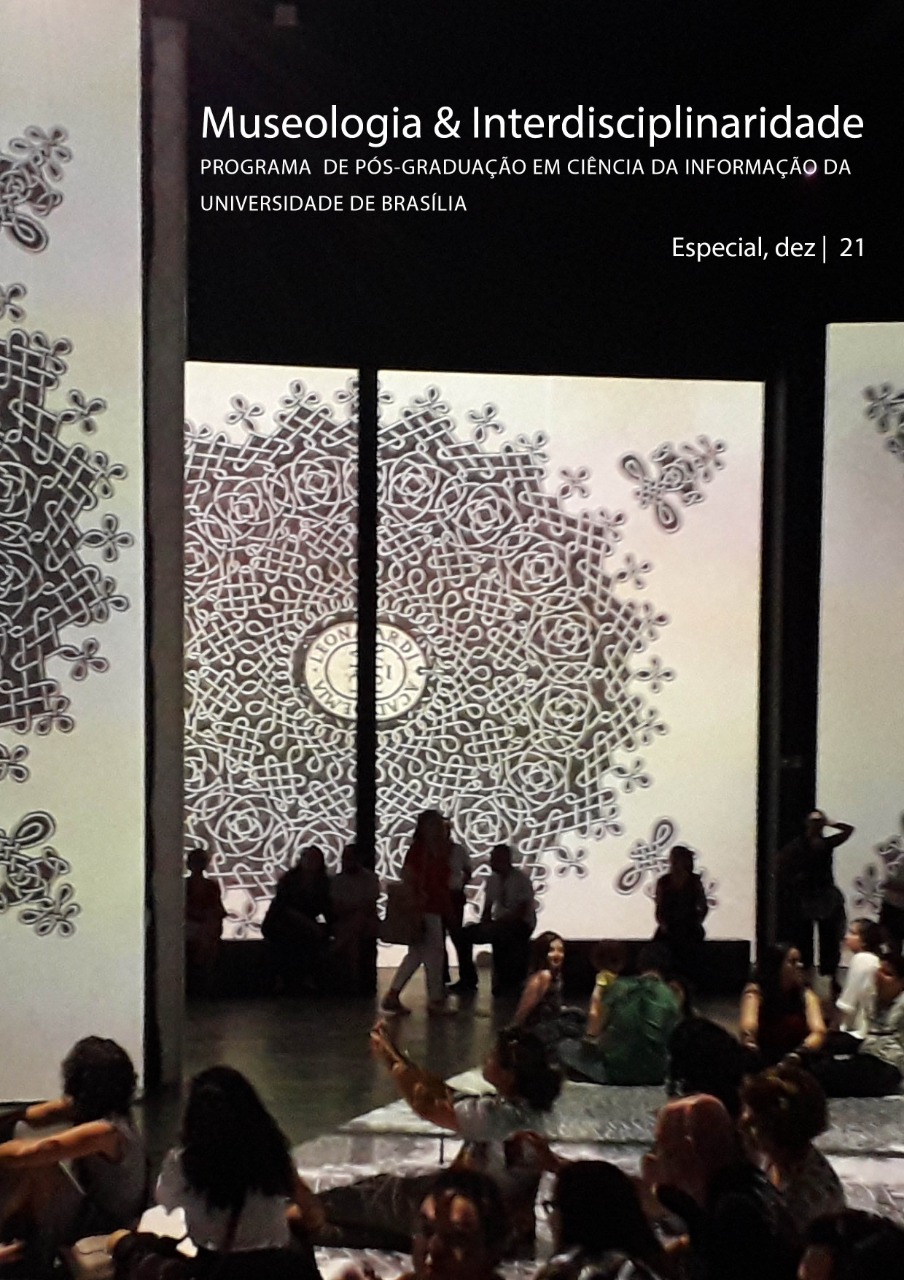Museums in cyberspace
social networks as a new dynamic for the digital public
DOI:
https://doi.org/10.26512/museologia.v10iEspecial.37506Keywords:
Museums in cyberspace, Museum social networks, Virtual audienceAbstract
Contemporaneity, deeply marked by the penetration of ICTs, strives to understand how Cyberculture will be able to combine activities, interactions and manifestations within an individualized and globalized but also “deterritorialized” territory. ICTs have become essential in the lives of most individuals, becoming practically their “second nature”, with speedy popularity and portability, exponentially expanding global network communication. The present study focuses on the results obtained from research to describe the interactions and shares found in the Museum of Tomorrow Facebook page, in Rio de Janeiro, and its virtual audience, before and after the closing of the institution as a result of the Covid-19 pandemic. Some issues are addressed about the paths of museums in the 21st century and how they can balance between traditions and digital technologies, between materialities and virtualities. These issues remain unclear, without defined horizons, in the face of the digital turmoil that challenges parameters and perceptions of global society.
Downloads
References
AGÊNCIA EFE – Genebra, Agência Brasil, 2018. Disponível em: https://agenciabrasil.ebc.com.br/internacional/noticia/2018-12/mais-da-metade-da-populacao-mundial-esta-conectada-internet-diz-onu.
BERGSON, Henry. Écrits et paroles. Paris, France: PUF, 1957.
CASTELLS, Manuel. A Sociedade em Rede, vol. I. A era da Informação: economia, sociedade e cultural. v.1, Rio de Janeiro: Paz e Terra, 2002. Disponível em: https://perguntasaopo.files.wordpress.com/2011/02/castells_1999_parte1_cap1.pdf. Acesso em: 12 jan. 2021.
DAVIS, Erik. Techgnosis: Myth, Magic, and Mysticism in the Age of Information. Berkeley, Califórnia : North Atlantic Books, 2015.
DURKHEIM, Émile. Da divisão do trabalho social. Martins Fontes: São Paulo, [1892] 2010.
FALK, John H. Identity and the Museum Visitor Experience. California, USA: Left Coast, 2009.
FOCILLON, Henri, El Año Mil. Madrid, ES: Alianza, 1966. Disponível em: https://vdocuments.net/focillon-ano-mil.html. Acesso em: 12 jan. 2021.
GENNEP, Van Arnold. Os Ritos de Passagem. Petrópolis, RJ: Vozes, [1909] 2012.
GIDDENS, Anthony. The Constitution of Society: Outline of the Theory of Structura-tion, Cambridge: Polity Press, 1984.
GONZALEZ, Rachel. Keep the Conversation Going: How Museums Use Social Media to Engage the Public. The Museum Scholar, Volume 1, Number 1, 2017. Disponível em: http://articles.themuseumscholar.org/vol1no1gonzalez. Acesso em: 21 jan. 2021.
HUGO, Victor. Notre-Dame de Paris. Paris: Gallimard, [1831] 1996. Disponível em: https://freeditorial.com/en/books/notre-dame-de-paris--3. Acesso 20 mar. 2021.
JUNG, Carl G. Os arquétipos e o inconsciente coletivo. Petrópolis, RJ: Vozes, 2002. Disponível em: fi-le:///C:/Users/helen/Downloads/Os%20arqu%C3%A9tipos%20e%20o%20inconsciente%20coletivo.pdf. Acesso em: 12 jan.2021.
LÉVY, Pieree. Cibercultura. São Paulo: Editora 34, [1997] 2014.
LÉVY, Pierre. O Que é o Virtual. São Paulo: Ed. 34, 1996.
NASCIMENTO JR. José; TRAMPE, Alan; SANTOS, Paula A. (orgs.) Mesa redonda sobre la importancia y el desarrollo de los museos en el mundo contemporáneo: Revis-ta Museum, 1973. Brasília: IBRAM/MinC; Programa Ibermuseos, 2012. Disponível em: http://www.ibermuseos.org/wp-content/uploads/2018/10/publicacion-mesa-redonda-vol-ii-pt-es-en.pdf. Acesso em 20 jan. 2021.
PRIMO, Judite (org.). Declaração de Quebec -1984. Princípios de Base de uma Nova Museologia. In: Cadernos de Sociomuseologia, Museologia e património: documentos fundamentais. Lisboa, PT: ULHT, v. 15 n. 15, p. 223-225, 1999. Disponível em: http://cultura.rj.gov.br/sec-admin/ablanc-adm/editais-ativos.php. Acesso em: 20 jan. 2021.
PROCTOR, Nancy. Digital Museum as Platform, Curator as Champion, in the Age of Social Media. CURATOR 53/1, janeiro 2010. Disponível em: http://networkedcu#rator.doingdh.org/wp-content/uploads/sites/11/2017/05/Proctor-2010-Curator__The_Museum_Journal.pdf. Acesso em: 12 jan. 2021.
QUEIROZ, Luiz. Capital Digital: economia e política no mundo digital. Disponível em: http://www.capitaldigital.com.br/o-futuro-e-analogico/. Acesso em: 25 jan. 2021.
SANTAELLA, Lúcia. Da cultura das mídias à cibercultura: o advento do pós-humano. Revista FAMECOS, Porto Alegre, nº 22, dezembro 2003. Disponível em: http://revistaseletronicas.pucrs.br/ojs/index.php/re%20vistafamecos/article/viewFile/3229/249 3. Acesso em: jan. 2021.
SCHEINER, Teresa, C. M. Museologia, hiperculturalidade, hipertextualidade: refle-xões sobre o Museu do Século 21. Museologia & Interdisciplinaridade, Vol. 9, nº17, Jan. / Jul. de 2020. Disponível em: https://periodicos.unb.br/index.php/museologia/article/view/31592/26175. Acesso em: 23 dez. 2020.
SCHEINER, Teresa, C. M. Criando Realidades Através de Exposições. In: GRANA-TO, Marucs; SANTOS, Claudia P. (orgs.) Discutindo Exposições: conceito, construção e avaliação. Rio de Janeiro: Museu de Astronomia e Ciências Afins (MAST), 2006. 120p.
STAHL, Willian. God and the Chip: Religion and the Culture of Technology. Water-loo, ON: Wilfred Laurier University Press, 1999.
UZELAC, Aleksandra. How to understand digital culture: digital culture - a resource for a knowledge society? In: UZELAC, Aleksandra ; CVJETIEANIN, Biserka (eds.). Digital Culture: The Changing Dynamics. Zagreb, Croatia: Institute for International Relations, 2008. Disponível em: file:///C:/Users/helen/Downloads/digital_culture-enknjigaskoricama.pdf. Acesso em: 12 jan. 2021.
WEISSBERG, Jean-Louis. Real e Virtual. In: PARENTE, André (Org.). Imagem má-quina: a era das tecnologias do virtual. Rio de Janeiro: Ed. 34, 1993.
Downloads
Published
How to Cite
Issue
Section
License
Copyright (c) 2021 Museologia & Interdisciplinaridade

This work is licensed under a Creative Commons Attribution-NonCommercial-NoDerivatives 4.0 International License.


